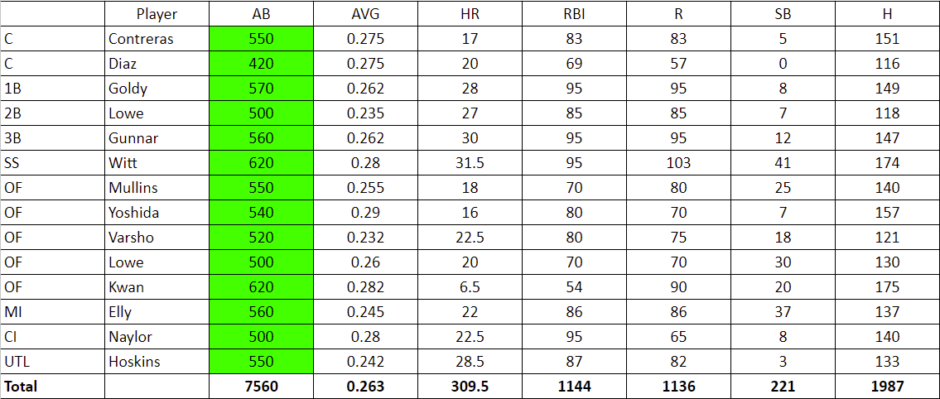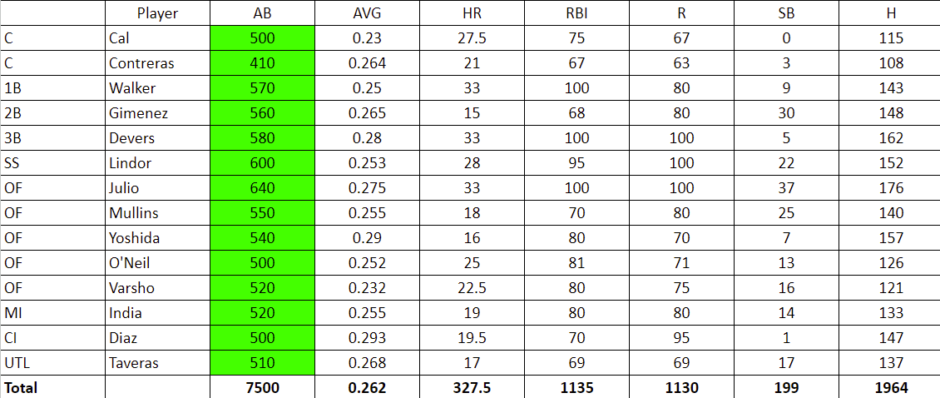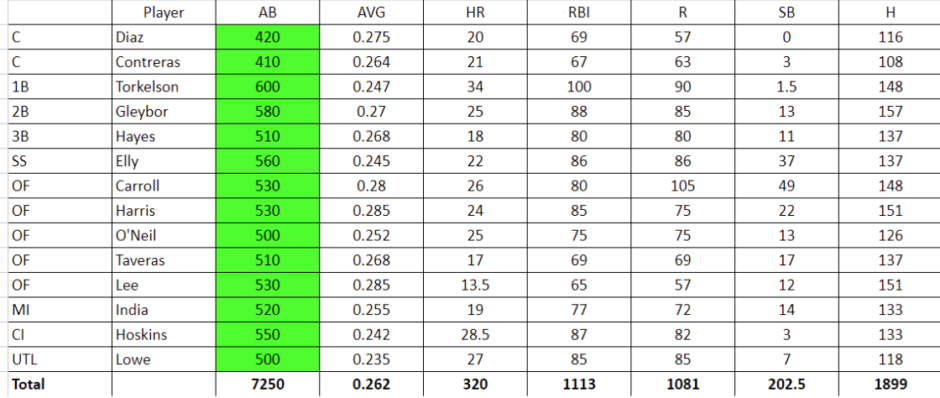League Background
This is a 12-team mixed NFBC draft. The roster consists of 14 hitters, nine pitchers and seven bench players. You set your pitchers once a week; hitters are set twice a week; waivers occur once a week.
Overall Thoughts
This was my third and final draft. Like with my second draft, at the top of the draft I wanted to draft players I’ve already drafted to hedge injury risk. I planned on Michael Harris being available with my third pick but that didn’t happen so I had to go off script and adjust my team on the fly which I hate doing. That’s why you see players like Paul Goldschmidt and Josh Naylor on my team.
Unlike my previous drafts I prioritized starting pitching than closers with my earlier picks. The idea was to do something different. I picked one closer and tried to get cheap saves near the end of the draft, which I think I may have achieved.
I also took a shot on a lot of injured players in the middle rounds with Josh Lowe and Jhoan Duran. It appears Duran may only miss 3-4 weeks; having him on the roster is essentially the same as holding a lottery ticket back-up closer/setup man. Bryan Woo and Nick Lodolo were too cheap to pass up. There’s no structural damage to Woo’s elbow and Lodolo should only miss 15 days. Typically I only want 1-2 injured players because injuries do happen in-season and streaming pitching is extremely important especially early in the season.
In regards to my hitting I don’t have enough power but I have more stolen bases than I need so hopefully that counterbalances.
Of the three teams, I think my best team is the $250 league. This current team will have the most variance in performance. If I’m correct about the three injured pitchers and I can get enough saves in April, I think I have the best pitching staff this year.
My Team
Below is my team with my projections; not listed are my bench players but they will be discussed below the images:


Individual Player Analysis
Bobby Witt (#2) – Could Witt go 30/50? I think its very possible. If he had a better supporting cast you could make an argument he could be taken first overall.
Gunnar Henderson (#23) – In an effort to diversify my teams, I took Gunnar here. I wanted Francisco Lindor but he went right before my pick.
Elly De La Cruz (#26) – I wrote about Cruz here. I actually had Cruz rated higher than Gunnar. I wanted Michael Harris but he went right before my pick.
Yoshinobu Yamamoto (#50) – I’m not worried about his start. In fact he will be on my bench because I think he will only get to throw 80ish pitches which means, maybe, only 4-5 innings. That’s not enough for me to take on the risk of the bad start in Korea.
Logan Webb (#53) – I think Webb is Matt Cain 2.0. I had Webb 12th overall among starting pitchers. I think Webb pairs well with Yamamoto in that Webb maybe won’t provide the strikeouts of a fantasy ace but he should provide 190 innings with a very low WHIP.
Andres Munoz (#71) – I wrote about Munoz here.
Paul Goldschmidt (#74) – I don’t like drafting older sluggers because their performance can fall apart quickly. However, all indications says he works hard at Driveline every offseason so if there is someone who can mitigate the aging curve it’s Goldschmidt.
William Contreras (#95) – He was my number one catcher because I think he’s probably the only catcher who plays in 150 games. The Brewers desperately need offense and Contreras is either their best or second best hitter. The Brewers will carry three catchers which hopefully means he plays every day.
Josh Naylor (#98) – If I were to redraft my draft I would not have taken Naylor but at the time I wanted a good batting average to counterbalance my earlier picks.
Cedric Mullins (#119) – I wrote about Mullins here.
Yainer Diaz (#122) – I wrote about Diaz here.
Josh Lowe (#143) – I wasn’t a big fan of Lowe before the injury but at this price I think it was worth the risk/reward. Before the injury I projected a .260 average with 20/30. If I can get five months of that production Lowe is a steal. Also, I think once healthy he should play almost every day; the Rays lineup is very top heavy so even if he struggles against lefties he should still play every day.
Jhoan Duran (#146) – At the start of March Duran was my number three closer. I would not have taken Duran if there was something wrong with his elbow or shoulder. Instead it’s an oblique and hopefully he will be ready to go in 3-4 weeks.
Rhys Hoskins (#167) – I wrote about Hoskins here. At this point in the draft I knew I desperately needed power.
Masataka Yoshida (#170) – I wrote about Yoshida here.
Daulton Varsho (#191) – I wrote about Varsho here.
Nestor Cortes (#194) – Despite his health, Cortes’ advanced statistics looked better than the back of the baseball card statistics. Will he repeat his 2022 season? Probably not but I think a 3.80 ERA with a strikeout per inning is doable.
Steven Kwan (#215) – I was going to daft Lowe so I wanted additional batting average protection and at this point in the draft I could only look at outfielders. Kwan was the best available option.
Brandon Lowe (#218) – Sure, Lowe is a batting average risk but he hit 39 home runs in 2021. I projected 27 home runs which I think is reasonable if he stays healthy.
James McArthur (#239) – Is he the closer? If yes, I hope he can be a bridge before Duran is healthy. If not, it’s a short week this week and hopefully I get 1-2 good appearances.
Jorge Polanco (#242) – Polanco is a very solid player who’s going to hit third and play every day. I project a .255 average with 20-25 home runs. Polanco is my backup second baseman.
Yusei Kikuchi (#263) – Kikuchi has a high WHIP but I can afford it because I drafted Webb.
Leody Taveras (#266) – I wrote about Taveras after my first draft.
Tanner Houck (#287) – Houck is a two-start pitcher next week; at the A’s and at the Angels. I also like the raw stuff.
Trevor Megill (#290) – Short week this week; I’m hoping for good 1-2 appearances. I think Megill is the best reliever in the Brewers bullpen so my guess he is the odds-on favorite to close. If I’m wrong, I just drop him.
Seth Lugo (#311) – I need innings and Lugo should provide them. I’m always going to start him at home and it will probably be 50/50 on the road.
Nick Lodolo (#314) – This is a bet on his raw stuff and hopefully he can stay healthy.
Bryan Woo (#335) – I have Woo in all my other drafts. I don’t know why he fell. His elbow looks fine. “Fortunately the MRI, everything else came back very clean structurally,” Hollander said of Woo (source:Seattle Sports).
Aroldis Chapman (#338) – Short week this week; I’m hoping for good 1-2 appearances.
Jason Adam (#359) – Short week this week; I’m hoping for good 1-2 appearances.







